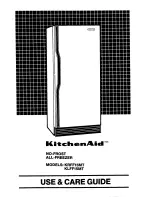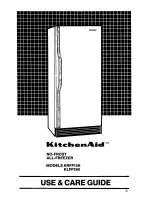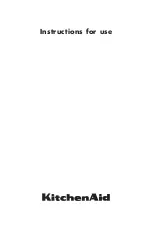
9
GB
Therefore you should avoid installing your freezer in very
humid surroundings. The LOW FROST system minimizes
the amount of ice caused by the natural temperature
cycle of the freezer. However, ice-build-up from other
sources is not reduced. The most important other
sources are poorly wrapped food and warm air
introduced when the lid is opened.
Therefore, it is important to ensure that the lid isnt
opened unnecessarily, and the lid is not obstructed by
packs of food when closed.
If food stored in the freezer is not wrapped properly,
humidity from the food will settle as ice on the freezer
walls. Food quality will also deteriorate, so ensure that
food put in the freezer is wrapped well.
Maintenance and Cleaning. The LOW FROST system
does not need any maintenance or cleaning during
normal use. If needed the pipe can be wiped with a soft
cloth. Do not use any sharp or piercing tools, as this may
damage the system.
THE ROLE OF THE PRESSURE
EQUALISATION VALVE (10)
The pressure equalisation valve installed in your freezer
automatically eliminates the pressure difference which
otherwise would make it very difficult or even impossible
to open the lid.
It may be possible to hear the operation of the valve as
the air flows in through the airing outlet in the rear wall of
the cabinet.
For a safe operation, keep the two openings of the valve
clear, do not cover them!
HELPFUL HINTS
STORAGE
Frozen food can be stored anywhere inside the
freezer, but should be kept at least 5 mm below the
top edge. Never exceed the maximum storage time for
purchased frozen food. When you buy frozen food, make
sure that it has been stored at the correct temperature. Do
not buy products which have wet or damaged packaging.
Place purchased products in your freezer as quickly as
possible. We recommend using an insulated bag to bring
such products home with you. Never place bottles, warm
objects, or fizzy drinks in the freezer.
FREEZING
Only use fresh food of the best quality. Cool hot
dishes to room temperature as quickly as possible
before placing them in the freezer. Wrap food carefully in
freezer foil, or use the special freezer boxes or bags
which are on the market. Divide food into small portions
before freezing - this ensures that freezing is more rapid,
and means that you only need to defrost the amount
needed for immediate consumption.
Remember that defrosted food must not be re-frozen.
However, dishes which have been made using defrosted
food may be frozen. Mark the freezer packaging with the
date of freezing. We recommend keeping a record of the
contents of your freezer. If freezing is too slow, the quality
of the food being frozen deteriorates. Consequently, do
not freeze larger amounts than stated in the freezers data
plate. If you wish to freeze food several days in a row, the
maximum freezing capacity stated per day is reduced by
about one-third. As far as possible, keep the lid closed
during freezing. If you know nothing about home freezing,
we recommend that you purchase a book containing
advice and guidelines.
DEFROSTING
In general food should not be defrosted at room
temperature, since this increases the risk of
bacteria growth. It is best to defrost large portions of
meat or poultry in the refrigerator, and this also applies to
food which is to be consumed as it is (e.g. fruit, butter
and sliced meat). Small portions of food can be cooked
straight from the freezer. A good number of ready-to-
cook dishes can also be cooked without defrosting.
Always observe the instructions on product packaging.
Bread tastes good when defrosted in a moderate oven.
Microwave ovens can be used for the rapid defrosting of
most frozen foods. Observe the instructions for use of
the microwave oven concerned.
ACCESSORIES (11)
Spare baskets can be obtained from your local
Service Centre. The illustrations on this page
show how many baskets can be placed in the various
freezer models. Measure the length of your freezer and
find the appropriate illustration. The number above each
illustration indicates its length in millimetres.
MAINTENANCE
DEFROSTING (12)
The formation of frost on the inside of freezers cannot be
avoided. Frost is formed when moisture contained in the air
comes into contact with the cold surfaces of the freezer.
Consequently, the lid should only be opened when
necessary, and it should never be left open.
A thin layer of ice or frost does not affect the function of
the freezer adversely, and can be removed carefully
using the scraper provided.
IMPORTANT
Never use a knife or any other sharp implement to
remove frost.
When the frost or ice layer is 10-15 mm thick, the freezer
should be defrosted. We suggest that you defrost your
freezer when there is little or no food inside.
Switch off the current. Remove the contents of the
freezer, wrap them in newspapers, and leave them in a
cold place.
The speed of defrosting can be increased by placing one
or more bowls of hot (not boiling) water inside the freezer
and closing the lid. Open the lid after a while, and remove
the layer of ice carefully.
The defrost water can be collected in the partition wall as
shown in the drawing.
Do not try to speed up defrosting by using anything other
than hot water, since this may damage the freezer. After
defrosting, clean the inside of the freezer.
Summary of Contents for ECS 2651
Page 2: ...2 1 7 2 8 3 4 FREEZING CAPACITY 5 6 9 ...
Page 3: ...3 13 11 12 10 ...





























